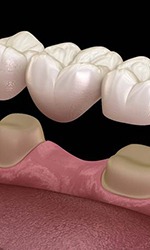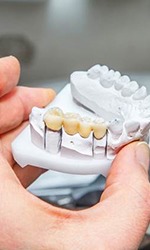Dental Bridges – Studio City, CA
Fill the Gap in Your Smile!

If you’ve lost a tooth, you know how challenging it can be to complete daily tasks. This includes chewing your food, speaking clearly, and smiling without feeling self-conscious. The good news is that there are a variety of tooth replacement options out there to fill in the missing spaces. At Studio City Dental Arts, we offer customized dental bridges to restore the appearance and function of your smile. To learn more about dental bridges or to find out if one is right for you, give us a call to schedule your next visit.
Why Choose Studio City Dental Arts for Dental Bridges?
- Customized for Optimal Comfort
- Flexible Financing Options
- Saturday Appointments Available
What is a Dental Bridge?

A dental bridge is a restoration that is used to replace one or more consecutive missing teeth. Generally, this is anywhere from one to four teeth in a row. A bridge comprises two dental crowns and the replacement teeth, also called the “pontics.” The crowns will be anchored onto your adjacent teeth or dental implants depending on the type of bridge that you end up getting. This restoration can be made from a variety of durable, natural-looking materials.
Types of Dental Bridges

There are two different types of dental bridges that meet different needs. Here is what you can expect from both of them.
Traditional Dental Bridges
For patients who still have healthy teeth on either side of the gap, a traditional denture is usually ideal. The teeth that support the dental crowns are known as “abutment teeth,” and they are altered slightly so the bridge fits comfortably in the mouth. This type of restoration can be placed in just a few visits to the dental office and is typically the more affordable type of bridge.
Implant Bridges
If you don’t have healthy adjacent teeth, surgically implanted metal posts, also known as dental implants, can provide an alternative. Dental implants can be used when there are three or more missing teeth in a row. Implant bridges last longer than traditional bridges on average, and they also prevent bone loss from occurring over time.
The Benefits of Getting a Dental Bridge

Here are just some of the many benefits you can experience when you opt for a dental bridge:
- Prevents dental drift
- Improves self-esteem
- Improves chewing ability
- Lowers risk of oral health issues
- Cost-effective
- Improves speech articulation
Dental Bridge FAQs
Can You Take a Dental Bridge Out?
No – dental bridges are designed to remain in your mouth for many years after being placed. You shouldn’t be able to remove your bridge on your own. Some healthcare providers may refer to partial dentures as “removable bridges,” but this isn’t entirely accurate. Partials may be similar to bridges, but one of the key differences is that partials can be removed by the patient at any time, while a dental bridge cannot.
How Many Teeth Can a Dental Bridge Replace?
Depending on the patient’s needs, a dental bridge can replace anywhere from one to four missing teeth in a row. However, in the majority of cases, bridges are used to replace only one or two teeth. The longer the bridge extends, the less stable it becomes – especially if the natural teeth supporting the bridge aren’t in optimal shape. It can become risky to have a bridge replace three or more teeth.
Do Dental Bridges Look Natural?
Metal-free dental bridges are made from materials that are color-matched to your surrounding teeth. These materials look just like natural tooth enamel, even in the way that light bounces off of them. Once placed, your dental bridge should blend in with the rest of your smile well. Bridges also don’t move around like an ill-fitting denture would, so you don’t need to worry about it shifting unnaturally or falling out.
Can Dental Bridges Get Cavities?
It is impossible for a dental bridge itself to develop cavities, but the natural teeth beneath it still can. Food debris can become trapped beneath the pontics or the space where the crowns meet the gums, attracting harmful bacteria to the area that can result in cavities. That’s why it’s so important that you maintain an excellent oral hygiene routine and clean under and around your bridge every day.
Are Dental Bridges Covered by Insurance?
Yes, bridges are usually partially covered by dental insurance plans. However, the level of coverage can vary between different providers and plans. Most plans consider bridges to be a major procedure, so they will typically cover about 50% of the cost. You also need to consider whether you have met your deductible and not exceeded your maximum. If you have any questions regarding your coverage, don’t hesitate to contact one of our friendly team members.
